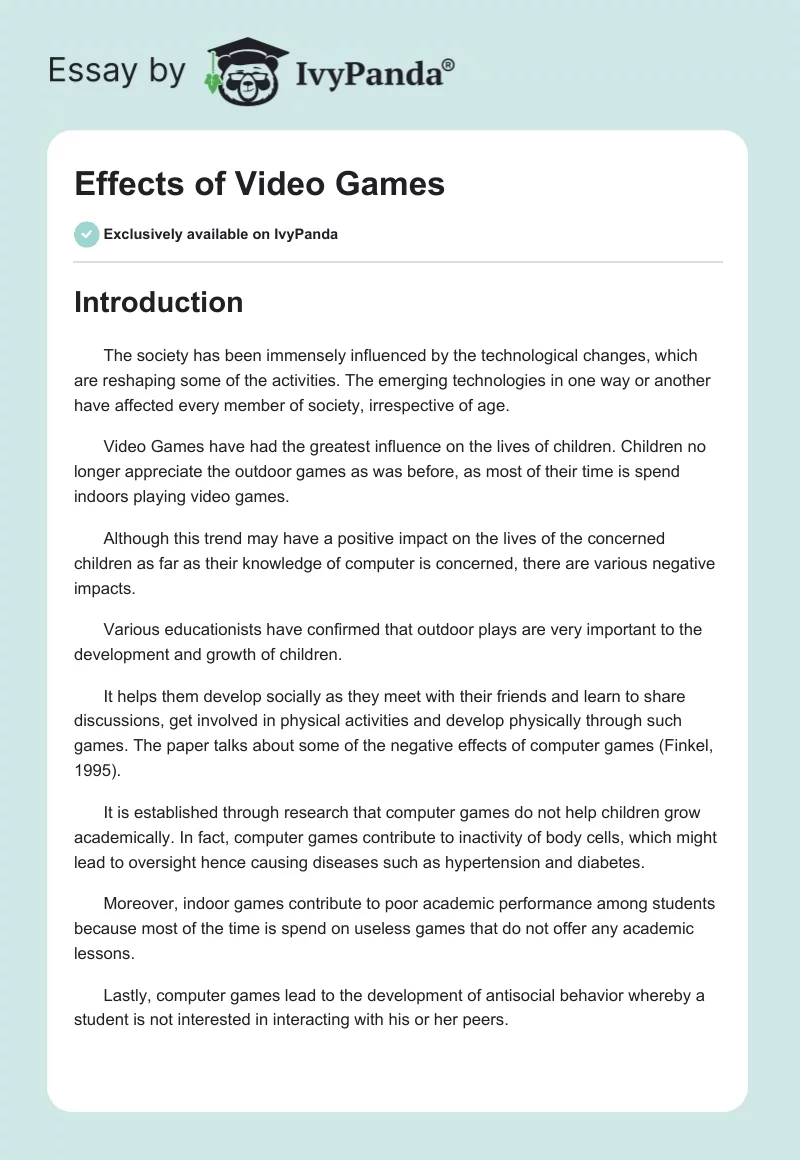Introduction
The society has been immensely influenced by the technological changes, which are reshaping some of the activities. The emerging technologies in one way or another have affected every member of society, irrespective of age.
Video Games have had the greatest influence on the lives of children. Children no longer appreciate the outdoor games as was before, as most of their time is spend indoors playing video games.
Although this trend may have a positive impact on the lives of the concerned children as far as their knowledge of computer is concerned, there are various negative impacts.
Various educationists have confirmed that outdoor plays are very important to the development and growth of children.
It helps them develop socially as they meet with their friends and learn to share discussions, get involved in physical activities and develop physically through such games. The paper talks about some of the negative effects of computer games (Finkel, 1995).
It is established through research that computer games do not help children grow academically. In fact, computer games contribute to inactivity of body cells, which might lead to oversight hence causing diseases such as hypertension and diabetes.
Moreover, indoor games contribute to poor academic performance among students because most of the time is spend on useless games that do not offer any academic lessons.
Lastly, computer games lead to the development of antisocial behavior whereby a student is not interested in interacting with his or her peers.
Overweight
Available literature shows that more children are growing obese owing to the fact that they spend little time exercising and engage frequently with the computer.
Research shows that children who take part in physical exercises are more healthy, intelligent, and active in class. The study conducted by American Heart Association proved that children are contracting heart diseases mainly because of lack of physical activity.
The research indicated that the number of obese children increased by four percent in 1974. Those affected were children aged six to eleven years.
However, the percentage increase could not be compared with the study conducted in 2006 whereby the increase rate was seventeen percent. As from 1971 to 2006, the number of adolescents thought to be obese increased from 6.1 percent to 17.6 percent.
The percentage increase was shocking. Furthermore, the increase was attributed to lack of physical activity and video games (Wiegman, & van Schie, 1998).
Overweight is a costly condition that leads to a number of illnesses among school going children. According to experts at the University of Michigan, obese children have higher risks of contracting diseases such as diabetes, heart diseases, and high blood pressure.
Other illnesses associated with overweight include high cholesterol levels in the body, hyperlipidemia, sleep apnea, respiratory problems, gastrointestinal malfunctions, early adolescence, and finally mental problems.
Studies show that obese children tend to have a low sense of worth and despair.
As AHA records show, obese children are likely to be obese when they attain the adulthood age. This would even cause more problems because they would be exposed to a number of diseases.
A study conducted by Media Literacy Clearinghouse indicated that children had developed a habit towards computer games. Video games had gained relevance among children aged eight and eighteen years to an extent that the rate at which children played computer games rose from an average of 26 minutes in 1999 to 73 minutes in 2009.
Generally, the rate at which children interacted with the computer daily rose from six hours in 1999 to seven hours in 2009. A report compiled in 2004 at the University Hospital of Zurich revealed that a strong link between obesity and video games exist.
It can be concluded that video games do not help children in any way but instead it affects their health. Video games interfere with the children’s eating habits because such children would tend to consume food with high calories.
In this regard, parents need to monitor the behavior of their children as regards to physical fitness.
School Performance
In the United States, a study conducted to ascertain the effects of computer games on the performance of students proved that PlayStations and other video games such as Xbox Video affects the concentration of children in class.
Furthermore, the study revealed that children who are like using playing video games could not compete favorably with those who prefer physical games. One of the researchers was quoted saying that the performance of students who engage in physical exercises will always improve with time.
Boys are affected more by the new trend since they would rarely improve in class. Their performance would always remain stagnant for a period.
Moreover, boys cannot develop skills that would help them to read and write well in case they are allowed to interact with the computer frequently (Sakurai, 1984).
It should be noted that video games might not necessarily cause poor performance among school going children but the time spent in watching the games or playing them would consume the time that a student would be expected to read, do some homework, and write a good composition.
Definitely, a student would register a poor grade in case he or she does not engage in a serious research. Video games have a tendency of instilling negative reading attitudes to students. This is because a student would find reading a storybook or solving a mathematics problem boring.
Video games are very fast and demand a higher concentration unlike other academic activities that need time for conceptualization. In a joint study conducted in Australia, researchers concluded that video games affect the performance of students in many ways.
Students who spend time playing video games would always perform dismally in class. In fact, the study revealed that computer games do not help children perform well in any of the subjects. This is because students who spend time watching and playing computer games would always score low in each subject.
This research contradicts some of the assumptions that computer games help children to perform well in some subjects. The Australian study revealed that there is no single positive correlation between academic performance and computer games.
Effects on Social Relationships
Video games are known to influence the cognitive and educational dexterities of children. Moreover, the games can as well as define the children’s social relationships. In a traditional setting, the relationship between the child and the parent or other senior members of society is clearly defined.
The video games have changed meaning that social relations are no longer the same. Studies indicate that video games, especially those that are violent, reshape the behavior of children. Moreover, video games could contain some sort of competition and aggression, which affect the reasoning of children.
In the current society, the rate at which conflicts occur in society has increased. Youths are currently violent because of the new games. The main objective of video games, according to Nintendo and Sega Genesis Center, is violence.
Any game played by children via the computer does not have anything new other than violent content. The companies specializing in selling computer games would convince parents that the games are non-violent but in the real sense, they are not.
A study conducted in 1998 confirmed that many children, over 80%, were familiar to a violent game referred to as Duke Nukem. Unfortunately, only 5% of parents were aware of the game meaning that children are access even those games that are supposed to be accessed by only the adults.
This trend affects the social life of children. In 1999, students at Columbine High School in Littleton, Colorado engaged in a destructive demonstration mainly because of the influence of computer games.
Students shot at their fellow teens and other people because they experienced it through video games. Such kind of behavior is destructive because it could lead to social anomy (Griffith, 1999).
Studies across the world indicate that violent video games increase an individual’s hostility and aggression. Aggressive games would lead to a habit whereby students prefer to play the games rather than engage in physical exercises.
This is even related to overweight. Children who are used to video games tend to be indifferent and unresponsive to the sufferings of other children. They would easily bully their fellow students without mercy.
References
Finkel, S. (1995). Causal analysis with panel data. Thousand Oaks, CA: Sage
Griffith, M. (1999). Violent video games and aggression: A review of the literature. Aggression and Violent Behavior, 4(2), 203-212.
Sakurai, S. (1984). Construction of the Social Desirability Scale for Children. Japanese Journal of Educational Psychology, 32(2), 310-314.
Wiegman, O., & van Schie, E. (1998). Video game playing and its relations with aggressive and pro-social behavior. British Journal of Social Psychology, 37(2), 367- 378.


